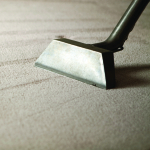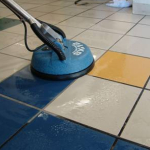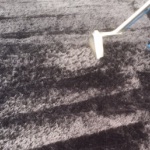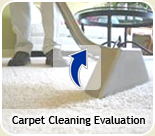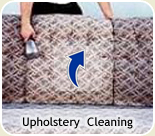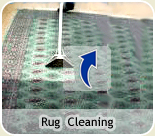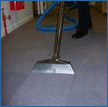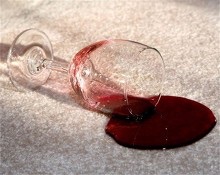Help us build our Clean Plan FAQ page!
- Carpet cleaning - our professional carpet & rug cleaning service (inc. stain removal & sofa cleaning) - we can also kill dust mites
- Pet urine cleaner - if you suffer from cat urine, dog urine or any other pet urine problem
- Tile & grout cleaning - inc. restoring Natural Stone, e.g. Limestone marble, travertine, slate terracotta, sandstone...
Send your questions to us by completing the form at the end of this page.
 Q: How long does the carpet cleaning process take?
Q: How long does the carpet cleaning process take?
A: We are able to clean approximately 400 square feet per hour. This can vary slightly depending upon the amount of soil, how much furniture needs to be moved, speciality spotting procedures, and setup time.
Q: How soon can I walk on the carpet?
A: Try to keep pets, children, and heavy traffic off the carpet during the drying process. Wait 24 hours before removing styrofoam blocks or protective tabs that our technicians have placed under the furniture to protect the carpet. Some carpets may feel slightly damp for up to 18 hours depending on the carpet and soil conditions. This is normal and will not cause any problems.
Q: Do you move furniture?
A: All of our cleaning packages include moving the majority of furniture in the main living area. (Most companies will charge you extra for this service.) Beds, dressers, and heavier pieces are left in place under these pricing structures. Additional charges will apply to move heavier furniture. For liability reasons, we do not move china hutches, entertainment systems, pianos, or other valuable belongings.
Q: What about reoccurring spots?
A: If a spot returned a day or so after cleaning: it may have been oily or sticky and was not completely removed, or “wicked back” due to the nature of the spot. Possibly it’s not a spot, but a permanent stain. [so what is the action to take, if it wasn’t removed?]
Q: My carpet has bleached or faded spots – can you correct that?
A: If you have spots or small areas that have been bleached out, they may be spot-dyed, depending on the type of carpet fibre.
Q: Can you fix indentations from heavy furniture?
A: No guarantee can be made on removing indentations from heavy furniture. In addition to the pile of the carpet being crushed, the backing of the carpet is indented. Heat, moisture, and hand grooming with our equipment may help, but it will take time to release back to normal, if at all. Severe cases may be permanent.
Q: How often should a carpet be cleaned?
A: No doubt this question has surfaced at one time or another during the years you’ve owned carpeting. The frequency of cleaning will vary from one household to another depending upon the number of occupants and level of usage. At a minimum, you should clean once a year.
I have had some home owners express their fear that once the carpet is cleaned, it will re-soil quicker. This fear is the result of improper cleaning by other cleaning companies. Many of these companies, in an effort to cut costs and save time, buy the cheapest cleaning solutions, don’t provide the proper training for their technicians, and do not offer a separate rinse step in order to remove detergent residues. If detergent is left in the carpet, accelerated re-soiling will occur.
Clean Plan uses a more thorough method of cleaning that uses a rinse step after the pre-spray process. This method removes deep down soil and leaves no detergent to accelerate the re-soiling process. The fact is, the best thing you can do for your carpets is have them regularly cleaned by a qualified professional carpet cleaning company. It is the buildup of soil that promotes wear to your carpet, far more than the foot traffic that travels on the surface of the carpet. Foot traffic grinds the soil against the carpet fibers and causes a sand-paper effect. This causes the fibers to dull and become worn looking.
Major carpet manufacturers such as Dupont and Shaw Industries recommend that you have your carpets cleaned every 6-18 months, and with most of today’s carpet, in order to satisfy the warranty requirements, you must save receipts from your cleanings. There are other considerations that can increase the frequency of cleanings, such as smoking habits, number and ages of children, soiling conditions, humidity, health status of occupants, allergy conditions, and number and types of pets just to name a few. Heavily traveled areas may require quarterly cleaning, while other less frequented areas may not need cleaning more than every 18 months. Either way, it makes good sense to have your carpets cleaned regularly—not only from an appearance and investment protection point of view, but also from a health standpoint. Regular deep cleaning removes bacteria, dust mites, germs, and the substances upon which these organisms live.
Q: Why should I clean my carpet?
A: Biocontaminants, volatile organic compounds, combustion products, asbestos, dust mites, chemical contamination, outdoor pollutants, pesticides, allergens, grease and oil deposits, sand, soil, food particles, bacteria, and a host of other really gross stuff will make its way into your carpet. Quite simply, your carpet acts like a sink. It collects and filters all of the above mentioned contaminants. This collection and filtering process traps these contaminants within your carpet, which in turns cleans the air you breathe and allows you to live a healthier life. Hard surface floors may allow contaminants to “roam” throughout the indoor environment.
However, like any other filter, your carpet needs to be cleaned on a regular basis, or it will lose its filtering ability. If these contaminants are in your home, they could be contributing to your family’s health and allergy problems. Dr Michael Berry, Deputy Director of the Environmental Criteria and Assessment Office of the Environmental Protection Agency stated, “Based on what I have learned from researchers working in the United States, Canada, and Western Europe, I have reached the conclusion that carpeting and fabrics that are not properly cleaned and maintained have the potential to cause a variety of health problems inside the building and home environment.”
Q: Why should I have my carpets protected?
A: Dupont Teflon Carpet Protection helps you in two very important ways:
When this protective coating is applied to the carpet fibres, it puts a protective barrier around each fibre. This protective barrier resists moisture. When you do have a spill, it gives you a window of time to get it cleaned up. (See our Spotting Guide)
The other important way that this product helps you is in the area of wear. Having this protective coating on your carpet helps reduce the wear and abrasion caused by sand in the carpet. This protects the carpet from excessive matting, and in turn will cause your carpet to perform better.
Q: Can you remove specific stains? [Be sure to see our new Spotting Guide!]
A: At Clean Plan we can remove any spot that is not a permanent stain. However, there are conditions where permanent staining is present. The following is a list of conditions which may or may not allow spots to be removed. The percentage listed next to the condition is the percentage of CHANCE we have of removing it, NOT the percentage of stain that will be removed.
Yellowing (50%) - Yellowing can be as simple as neutralizing the spot or area by spraying a solution on it, or it can be impossible to remove. There are many unknown causes for yellowing. It is so common that we have several different products on our van just for yellowing.
Filtration Soiling (25%) - Filtration soiling is the black marks you see around the edges of your base boards. Typically we can get these lines to lighten, but seldom do they come all the way out. The particles in filtration soil are so fine, and go all the way down the sides of the yarn and through the backing of the carpet. This makes it very difficult to remove.
Urine (50%) - When urine is fresh and has not been cleaned using an alkaline spotter, the chances are good. If the urine has been there for a long time, the chances are slim. However, urine will continue to deteriorate the carpet, so it is extremely important to remove the urine deposits, even if the spot does not come out.
Vomit (50%) - Same as urine. (If red dye is present in dog or cat food, see red dye removal.) [Consumer feedback - it would be absolutely brilliant to have a list of cat and dog foods that are free of staining dyes! Pooh regularly regurgitates and some of the results are really hard to get out]
Blood (75%) - If no hot water or alkaline cleaning products have been used, chances are good. [please list alkaline cleaning products for those of us who aren’t sure]
Rust (85%) - Chances for rust removal are excellent.
Red Dye (5%) - Red dye is almost impossible to remove unless conditions are exactly right. If the carpet is new, the chances are better. In many cases the only way to remove red dye is with a heat transfer process in which we apply a product to the spot, lay a wet cloth over it, and apply an iron to cause the spot to transfer to the towel. The spot is then rinsed thoroughly. This is a special procedure and due to the extra time it requires, we do charge extra for this.
Lipstick (50%) - Chances are good that we will be able to remove it with solvents. However, some lipstick may be in the red dye category which gives it a slim chance for removal.
Furniture Stain (01%) - Almost impossible.
Soft drinks (95%) - Usually not a problem.
Tea & Coffee (50%) - Tannin spots sometimes cause a permanent stain. Many times when coffee or tea is spilled, it is very hot. This can cause a stain to be set into the carpet.
[I knock over more coffee than anything else and would love more specific advice here for immediate remedies]
Ketchup (50%) - If ketchup has red dye in it, it could leave a stain. But without red dye, it’s not a problem.
Mustard (15%) - Mustard can be very difficult to remove.
Paint (20%) - If it is a fresh spill the chances are much better. If it has already dried, chances are slim.
If you have any questions not answered above, please let us know in the form below:

 0800 695 6957
0800 695 6957

